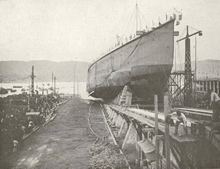Forges et Chantiers de la Méditerranée
Forges et Chantiers de la Méditerranée (FCM) was a major shipyard and armaments manufacturer in La Seyne-sur-Mer near Toulon in France . Today the company is part of the French mechanical engineering company CNIM .
history

In 1835 the English engineer Philip Taylor founded a factory in Menpenti , Marseille , which manufactured steam engines and marine engines. In 1845 he bought the “Chantiers de la Seyne” shipyard in La Seyne, which had converted from wood to metal construction in 1839, and had the business expanded on a large scale. From 1845 to 1848 the workforce grew from around 200 to 1,300, the business benefited among other things by the development of inland shipping and steam shipping , the growth of Mediterranean trade, the industrialization of northern Italy , and the conquest and colonization of Algeria . Taylor survived the crisis of 1848 and in 1853 he founded the "Compagnie des Forges et Chantiers de la Méditerranée", an integrated shipbuilding company in which he combined three companies: the "Forges de la Capelette" in La Capelette (Marseilles), who produced sheet metal and pipes, his factory in Menpenti, which built steam boilers and engines, and the "Chantiers de La Seyne", which built ships.
1855 sold Taylor society to one of Armand Behiç (1809-1891), the then director of the shipping company services Messageries Imperiales , led consortium, and the following year she was into a public limited company ( société anonyme ) with a capital of 4 million francs converted and Renamed "Société Nouvelle des Forges et Chantiers de la Méditerranée". Béhic stayed at the top of society for 35 years.
Within a few years, workshops for the production of iron armor, sheet metal and boilers were set up and export orders for warships to Russia, Italy and Brazil were fulfilled. In 1871 the company acquired the “Cie Anonyme des Chantiers de l'Océan” marine machinery factory owned by the Mazeline brothers in Le Havre , which at that time already had 920 employees, and a site in Graville-Sainte-Honorine where the “Chantiers de Graville” shipyard was built . In addition to building modern warships, the company was also heavily involved in the rearmament of French army artillery in the period from the Franco-Prussian War to World War I , and tanks were also built from 1917 .
During the Second World War , the plants were bombed several times, which interrupted production. The modernization after the end of the war was unable to neutralize the shipyard crisis that began in 1959 and the sharp decline in demand for warships. The FCM was on July 1, 1966 in bankruptcy .
It was taken over by the Herlicq Group and renamed " Constructions Navales et Industrielles de la Méditerranée ", the name from which the current company name "CNIM" arose. CNIM specialized thereafter to the production of special ships such as liquefied natural gas - and oil - tanker . At the same time, diversification into other business areas was promoted. In 1982, “CNIM” was renamed “Constructions Industrielles de la Méditerranée” and has since pushed the expansion of the energy and mechanical engineering divisions.
Armaments projects
FCM was involved in many armaments projects of the French military. In addition to shipbuilding and projects for the Marine nationale française , numerous projects for land vehicles were also carried out.
Shipbuilding
Ships built by FCM (selection)
- Brazilian tank corvette Brasil (1865)
- Turkish ironclad Âsâr-ı Tevfik (1868)
- Dutch monitor Schorpioen (1868)
- French passenger ship La Bourgogne (1885)
- French ship of the line Marceau (1887)
- Spanish ship of the line Pelayo (1888)
- Chilean ironclad Capitán Prat (1889)
- Greek ironclad Spetsai (1889)
- Greek ironclad Psara (1890)
- Japanese protected cruiser Matsushima (1890)
- Japanese armored cruiser Itsukushima (1890)
- French ship of the line Jauréguiberry (1893)
- Russian protected cruiser Svetlana (1896)
- French protected cruiser Châteaurenault (1898)
- French armored cruiser Montcalm (1900)
- Russian armored cruiser Bayan (1900)
- Russian ship of the line Zessarevich (1902)
- Russian armored cruiser Admiral Makarov (1906)
- French ship of the line Voltaire (1909)
- British hospital ship Salta (1911)
- British Canal Ferry Newhaven (1911)
- French ship of the line Paris (1912)
- French passenger ship Patria (1913)
- French aircraft carrier Béarn (1920)
- Greek sailing training ship Ares (1927)
- French Canal Ferry Cote d'Argent (1932)
- French passenger ship El Mansour (1932)
- French light cruiser Montcalm (1935)
- Norwegian cruise ship Sagafjord (1965)
Ships built by CNIM (selection)
- Italian cruise ship Melody (1982)
- Oil rig NOBLE Ronald Hoope (1982)
Tank construction
Below is an overview of the known projects for tank building by FCM.
literature
- Julien Turgan: Forges et Chantier de la Méditerranée , Les grandes usines: études industrielles en France et à l'étranger, Volume 7. Michel Levy Freres, Paris, 1868, pp. 305-320
- Steven J. Zaloga: French Tanks of World War II (1): Infantry and Battle Tanks , Bloomsbury Publishing, 2014, ISBN 978-1-4728-0776-2 .
- Kenneth W Estes: Super-heavy Tanks of World War II , Bloomsbury Publishing, 2014, ISBN 978-1-78200-384-7 .
Web links
Footnotes
- ↑ en: Philip Taylor (civil engineer)
- ^ La Construction Navale au Havre
- ↑ Steven J. Zaloga: French Tanks of World War II (1): Infantry and Battle Tanks , Bloomsbury Publishing, 2014, ISBN 978-1-4728-0776-2 .
- ↑ Kenneth W Estes: Super-heavy Tanks of World War II , Bloomsbury Publishing, 2014, ISBN 978-1-78200-384-7 .
Coordinates: 43 ° 6 ′ 29 ″ N , 5 ° 52 ′ 52 ″ E
